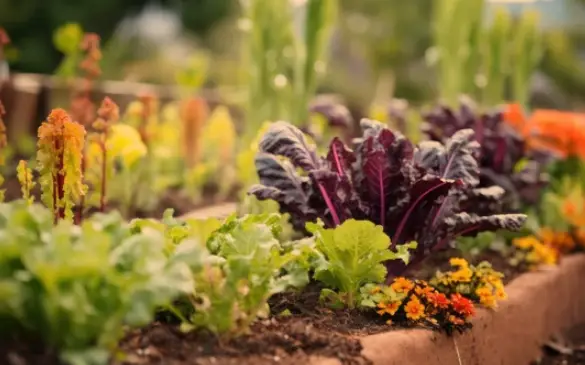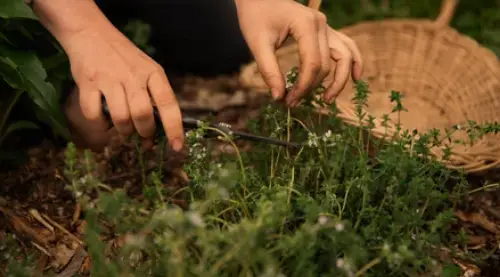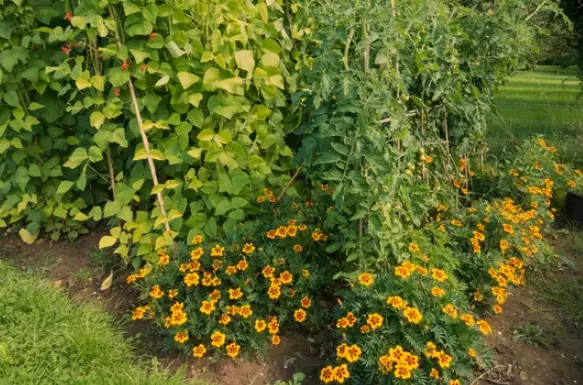Vegetable gardens often fall victim to destructive pests, threatening the hard work and rewards of gardeners.
The shift towards sustainable and natural gardening practices highlights the need for eco-friendly pest control solutions.
Companion planting offers an innovative and effective strategy to combat pests while promoting plant health and biodiversity.
What is Companion Planting?

Natural Pest Control
Companion planting is a gardening technique that involves strategically planting different crops in close proximity to one another to achieve various benefits.
This practice capitalizes on plant interactions to enhance growth, deter pests, improve soil health, and maximize overall garden productivity.
Companion planting is based on the principle that certain plants have mutually beneficial effects when grown together, while others may help repel pests or attract beneficial insects.
It’s a holistic approach to gardening that considers the relationships between plants and their surrounding environment.
Throughout history, indigenous cultures and traditional farmers have practiced companion planting to optimize crop yields and minimize the impact of pests and diseases without relying on synthetic chemicals.
Natural properties of different plants, gardeners can create a more resilient and balanced ecosystem within their gardens.
In essence, companion planting is a method that harnesses the power of plant relationships to create a harmonious and productive garden environment, promoting healthier plants and reducing the need for external interventions.
How Does Companion Planting Deter Bugs?

Companion planting operates as a botanical orchestra, employing a symphony of natural mechanisms to deter insects and safeguard the delicate harmony of your vegetable garden.
In this intricate performance, the plants themselves become skilled musicians, playing their roles to perfection.
Odor Masking:
Imagine aromatic herbs like basil, rosemary, and thyme releasing their captivating fragrances into the air, masking the scents that pests find irresistible.
Just as a strong perfume might overpower a subtle aroma, these herbs create an olfactory smokescreen, making it difficult for pests to locate their target crops.
The intricate chemistry of these scents confuses insects, disrupting their search for food and breeding grounds.
Insect Confusion:
The garden becomes a maze for unwelcome insects, thanks to the intriguing concept of insect confusion. Certain companion plants emit compounds that interfere with the sensory cues pests rely upon.
In this bewildering environment, pests struggle to differentiate between their desired host plants and the surrounding foliage, making them less likely to settle and cause damage.
Nutrient Enhancement:
Companion planting is more than just a visual spectacle; it’s a complex exchange of nutrients and information underground. Some plants forge alliances below the surface, releasing chemicals that improve the soil’s fertility.
This nutrient enhancement not only bolsters the health of your crops but also indirectly deters pests by creating a robust and inhospitable environment for them.
Trap Cropping:
Picture a sacrificial lamb drawing the attention of a predator, sparing the main flock. Similarly, companion plants can act as trap crops, luring pests away from your valuable vegetables.
These decoy plants beckon insects with their attractive traits, diverting them from your primary crops and preventing widespread infestations.
Nature’s Perfume Counter:
Alliums, such as garlic and onions, are nature’s perfume counter, emitting strong aromas that repel a multitude of pests. These pungent scents permeate the air, deterring insects from approaching and thus reducing the likelihood of damage to your crops.
Effective Companion Plants for Bug Repellent

In the mesmerizing tapestry of your vegetable garden, where the delicate balance between cultivation and nature’s whims intertwines, a diverse cast of characters takes center stage. Among them are the unsung heroes—companion plants—that wield their botanical prowess to repel pests, ensuring a thriving and harmonious ecosystem. Let’s venture into this verdant realm and explore the vibrant personalities that make up this ensemble.
1. Herbs as Natural Pest Repellents
Step into the aromatic realm of herbs, where nature’s fragrant defenders stand guard against insect invaders.
Basil, with its sweet aroma, not only enhances the flavors of your culinary creations but also deters flies and mosquitoes. Mint, a refreshing delight in beverages, serves as a formidable foe to ants, aphids, and rodents.
Basils robust scent not only elevates roasted dishes but also wards off cabbage moths and carrot flies.
Thyme, a versatile companion, battles against an array of pests, from whiteflies to tomato hornworms. These herbs, with their beguiling fragrances, create an invisible fortress that shields your crops from unwelcome guests.
2. Flowers for Pest Control and Pollination
Enter the realm of vibrant blooms, where the language of color and scent becomes a powerful tool in the art of pest control. Marigolds, with their cheerful golden hues, deter nematodes and aphids while attracting beneficial insects like ladybugs.
Nasturtiums, dressed in fiery shades, serve as a delectable feast for aphids, diverting them from your prized plants. Calendula, with its sunny disposition, repels whiteflies and discourages pesky aphids.
But these blossoms are not mere defenders; they are also charmers, luring pollinators to your garden, orchestrating a symphony of life that ensures the continuity of your vegetable harvest.
3. Alliums: Nature’s Bug Deterrents
Venture into the world of alliums, where pungent aromas and culinary delights converge to repel an array of unwanted visitors.
Garlic, with its robust flavor, sends a strong message to root maggots, Japanese beetles, and aphids: this territory is off-limits.
Onions, with their layers of flavor, also form layers of protection against pests like carrot flies and cabbage worms.
Chives, with their delicate oniony fragrance, create an environment that is inhospitable to aphids and thrips.
These alliums, with their potent scents, serve as nature’s vigilant guards, patrolling the borders of your garden and standing firm against intruders.
Lis Of Herbs as Natural Pest Repellents
In the fragrant haven of your garden, a secret alliance thrives a league of herbs that not only tantalize the taste buds but also wield their aromatic powers to defend against the onslaught of garden pests.
These culinary champions don a new mantle as nature’s guardians, repelling insects with their captivating scents and deterring the destructive forces that threaten your cherished crops.
Basil: The crown jewel of herb gardens, basil emerges not only as a culinary delight but also as a steadfast defender against common pests.
Its sweet and spicy aroma wafts through the air, masking the scent trails that pests follow. Aphids, whiteflies, and mosquitoes, bewildered by this aromatic symphony, struggle to locate their target plants. As you harvest leaves for your favorite dishes, basil’s insect-repelling magic dances on, safeguarding your garden’s vitality.
Mint: A refreshing treasure in teas and beverages, mint unleashes its aromatic artillery to deter a host of unwanted visitors. Ants, known for their relentless invasions, find their senses overwhelmed by mint’s powerful scent, steering them away from your garden beds.
Aphids, cabbage moths, and rodents also succumb to the overwhelming allure of mint, diverting their attention from your vulnerable crops. This verdant sentinel, with its vigorous growth, forms a formidable barrier against intruders.
Rosemary: Rising proudly in the garden landscape, rosemary exudes an earthy fragrance that transcends its culinary role.
Cabbage moths and carrot flies, known for their voracious appetites, find themselves repelled by the robust scent of rosemary. This herb’s essence not only elevates the flavors of roasted dishes but also acts as a sentinel, warding off pests that seek to feast on your garden’s abundance.
Thyme: As a versatile companion, thyme demonstrates its prowess as both a culinary ally and a vigilant defender. Its delicate fragrance, a medley of earthiness and herbaceousness, creates an atmosphere that deters an array of pests. Whiteflies, tomato hornworms, and cabbage loopers are among the unwelcome visitors that find thyme’s scent uninviting. With each sprig of thyme that graces your culinary creations, you bolster your garden’s defenses against these persistent foes.
Plant Combinations and Garden Layouts
In the garden’s intricate choreography, where plants sway to the rhythm of nature’s symphony, a harmonious partnership unfolds a dance of complementary companions and strategic layouts.
Here, the arrangement of flora takes center stage, weaving a tapestry of interdependence that not only maximizes space but also fortifies the natural defenses of your vegetable haven.
1. Creating Pest-Repelling Combinations
Imagine a garden where marigolds stand sentinel alongside tomatoes, and basil takes its place beside beans—this is the realm of pest-repelling plant combinations.
In this dynamic duet, marigolds unleash their aromatic prowess, deterring nematodes and whiteflies from wreaking havoc on your tomatoes. Meanwhile, basil lends its fragrant charm to beans, confounding pests and ensuring a thriving legume harvest.
These strategic partnerships not only defend against insect invaders but also enhance the growth of their companions, fostering a mutually beneficial alliance that embodies the essence of companion planting.
As you select your plant companions, consider the individual preferences and growth habits of each species.
Understanding the unique needs of your allies allows you to create harmonious unions that amplify the protective benefits and yield of your garden.
From the kaleidoscope of nature’s palette, emerge combinations that not only defy pest pressures but also celebrate the beauty of biodiversity.
2. Vertical Gardening and Succession Planting

Ascend into a new dimension of gardening the vertical realm, where space becomes an opportunity for innovation and pest control.
Taller companions, such as sunflowers and trellised cucumbers, assume the role of natural barriers, thwarting the advances of crawling pests.
As these towering sentinels guard the borders, cascading companions like trailing nasturtiums and vining beans embrace the vertical space, creating a living tapestry that captivates the eye and deters ground-dwelling insects.
Embrace the concept of succession planting, a symphony of growth that ensures a continuous supply of pest-repelling allies.
As one crop reaches its pinnacle, the baton is passed to the next, orchestrating a seamless transition that leaves no room for pest populations to proliferate.
In this evolving landscape, garden beds transform into stages, where each act unfolds with precision, fending off pests while nurturing your garden’s vitality.
Plant Combinations and Garden Layouts
In the garden’s intricate choreography, where plants sway to the rhythm of nature’s symphony, a harmonious partnership unfolds dance of complementary companions and strategic layouts.
Here, the arrangement of flora takes center stage, weaving a tapestry of interdependence that not only maximizes space but also fortifies the natural defenses of your vegetable haven.
1. Creating Pest-Repelling Combinations
Imagine a garden where marigolds stand sentinel alongside tomatoes, and basil takes its place beside beans this is the realm of pest-repelling plant combinations.
In this dynamic duet, marigolds unleash their aromatic prowess, deterring nematodes and whiteflies from wreaking havoc on your tomatoes.
Meanwhile, basil lends its fragrant charm to beans, confounding pests and ensuring a thriving legume harvest.
These strategic partnerships not only defend against insect invaders but also enhance the growth of their companions, fostering a mutually beneficial alliance that embodies the essence of companion planting.
As you select your plant companions, consider the individual preferences and growth habits of each species.
Understanding the unique needs of your allies allows you to create harmonious unions that amplify the protective benefits and yield of your garden.
From the kaleidoscope of nature’s palette, emerge combinations that not only defy pest pressures but also celebrate the beauty of biodiversity.
2. Vertical Gardening and Succession Planting
Ascend into a new dimension of gardening the vertical realm, where space becomes an opportunity for innovation and pest control.
Taller companions, such as sunflowers and trellised cucumbers, assume the role of natural barriers, thwarting the advances of crawling pests.
As these towering sentinels guard the borders, cascading companions like trailing nasturtiums and vining beans embrace the vertical space, creating a living tapestry that captivates the eye and deters ground-dwelling insects.
Embrace the concept of succession planting, a symphony of growth that ensures a continuous supply of pest-repelling allies.
As one crop reaches its pinnacle, the baton is passed to the next, orchestrating a seamless transition that leaves no room for pest populations to proliferate.
Maintaining a Healthy Garden Ecosystem

Amidst the vibrant splendor of your garden, a hidden world teems with life a subterranean realm where soil health and pest resistance intertwine to shape the destiny of your plants.
Here, the art of cultivation extends beyond the visible, delving into the realms of composting, mulching, and crop rotation to nurture a sanctuary of resilience and vitality.
1. Soil Health and Pest Resistance
Beneath the roots of your plants lies a crucible of life the soil, a bustling habitat of microorganisms, nutrients, and intricate interactions.
A healthy soil ecosystem is not merely a foundation; it’s a powerful ally in the battle against garden pests.
Nutrient-rich soil supports robust plant growth, enhancing their natural defenses and making them less susceptible to pest attacks. As your plants flourish, they become formidable adversaries to potential invaders.
The magic of composting, where kitchen scraps, garden debris, and organic matter blend to create a nutrient-rich elixir for your soil.
Compost not only feeds your plants but also nurtures beneficial microorganisms that aid in breaking down pests’ habitats.
2. Rotating Crops for Pest Management
Imagine a garden that evolves with each season, where the arrangement of crops becomes a tactical maneuver in the battle against pest populations.
Crop rotation emerges as a strategic weapon, disrupting the life cycles of insects and pathogens that rely on specific host plants.
Craft a well-designed rotation plan that takes into account the different plant families, ensuring that no species occupies the same spot for consecutive seasons.
As you orchestrate this dance of diversity, you thwart the attempts of pests to establish strongholds and weaken their ability to ravage your garden.
Crop rotation transforms your garden into a dynamic battlefield, where pests find themselves perpetually outmaneuvered and your plants stand united in their resilience.
Monitoring and Adaptation
In the delicate balance of your garden, where nature’s forces ebb and flow, a watchful eye and a nimble hand become your most powerful tools.
As we enter the realm of monitoring and adaptation, we unveil a realm of vigilance and responsiveness an essential aspect of nurturing a thriving and pest-resistant vegetable garden.
Here, we explore the art of observation, the science of organic remedies, and the principles of integrated pest management (IPM) to navigate the dynamic landscape of gardening.
1. Regular Inspection and Observation
Step into the role of a keen observer, attuned to the nuances of your garden’s rhythms.
Regular inspections unveil the hidden world of insect activity, revealing the subtle signs of impending pest pressures. Vigilance allows you to catch outbreaks early, when interventions can be most effective.
Monitor the health of your plants, noting any discoloration, wilting, or visible damage. Keep a watchful eye on the undersides of leaves, where pests often congregate. By staying connected to your garden’s pulse, you empower yourself to take timely action and protect your crops.
2. Organic Remedies and Integrated Pest Management (IPM)
Step beyond the realm of synthetic pesticides and embrace the arsenal of organic remedies. Invite nature’s allies to your garden a squadron of beneficial insects that serve as natural predators to garden pests.
Ladybugs, lacewings, and parasitic wasps are among the heroes that can be introduced to help keep pest populations in check.
Also, concoctions of homemade insecticidal soaps, neem oil, or garlic spray provide eco-friendly alternatives to chemical interventions.
Conclusion
In the wondrous tapestry of your vegetable garden, where soil, sunlight, and rain converge to create life, a harmonious symphony unfolds a testament to the power of nature’s intricacies and the gardener’s wisdom.
chemicals and interventions, but in the art of partnership with the natural world. Companion planting, with its aromatic herbs, vibrant flowers, and pungent alliums, showcases the potential for plants to stand united against pest pressures, defending one another with resilience and grace.
As you embark on your own gardening odyssey, remember that the symphony of companion plants, the ballet of layouts, and the hidden secrets of soil health are your allies. With each season, with every bloom and harvest, you weave a tale of resilience, beauty, and coexistence a story that celebrates the timeless bond between humanity and the natural world.




